Psychische Erkrankungen in der Lebensspanne ... - DGPPN
Psychische Erkrankungen in der Lebensspanne ... - DGPPN
Psychische Erkrankungen in der Lebensspanne ... - DGPPN
Sie wollen auch ein ePaper? Erhöhen Sie die Reichweite Ihrer Titel.
YUMPU macht aus Druck-PDFs automatisch weboptimierte ePaper, die Google liebt.
Topic 4 G Affektive Störungen, F3 // Affective disor<strong>der</strong>s, F3<br />
002<br />
Psychoanalytische Behandlung <strong>der</strong> chronischen Depression und<br />
ihre neuronalen Korrelate: E<strong>in</strong>e Verlaufstudie mit <strong>der</strong> fMRT<br />
Henrik Kessler (Universitätskl<strong>in</strong>ik Ulm, Kl<strong>in</strong>ik für Psychosomatik)<br />
003<br />
Treatment-resistant depression (TRD): current pharmacological<br />
treatment options<br />
Mazda Adli (Charité Campus Mitte, Psychiatrie und Psychotherapie,<br />
Berl<strong>in</strong>)<br />
Although the neurobiological basis of depression is far from be<strong>in</strong>g<br />
sufficiently un<strong>der</strong>stood thorough consi<strong>der</strong>able progress has been<br />
achieved <strong>in</strong> the recent years to un<strong>der</strong>stand important mechanisms<br />
on genetic, endocr<strong>in</strong>ological and cellular levels which open up potential<br />
novel and more specific treatment approaches. However,<br />
today strategies for the treatment of depression comprise a confus<strong>in</strong>g<br />
variety of options. About 30 antidepressants are currently on<br />
the market which ma<strong>in</strong>ly differ with regard to their side effect profiles.<br />
All biological treatment strategies (except for sleep deprivation)<br />
show a latency of onset of several weeks and a non-response<br />
rate of about 30 to 50 %. Therefore, <strong>in</strong> daily rout<strong>in</strong>e it has been<br />
shown useful to follow a stepwise sequence of therapeutic strategies<br />
and to perform a standardized evaluation of response at critical decision<br />
po<strong>in</strong>ts to avoid or to overcome TRD. Innovative pharmacological<br />
and personalized treatment approaches carry the promise of<br />
shorten<strong>in</strong>g treatment duration and <strong>in</strong>creas<strong>in</strong>g response rates <strong>in</strong> the<br />
near future. As of today, depressive disor<strong>der</strong>s show a good prognosis<br />
if the treatment options cover all available strategies and the response<br />
to a particular treatment is evaluated based on systematic<br />
treatment algorithms.<br />
004<br />
Deep Bra<strong>in</strong> Stimulation as a putative treatment for treatment-<br />
resistant depression<br />
Thomas Schläpfer (Universitätskl<strong>in</strong>ikum Bonn, Psychiatrie und Psychotherapie)<br />
Introduction: A substantial number of patients suffer<strong>in</strong>g from severe<br />
neuropsychiatric disor<strong>der</strong>s do not respond to conventional<br />
therapeutic approaches. Results from functional neuroimag<strong>in</strong>g research<br />
and the development of neuromodulatory treatments lead to<br />
novel putative strategies.<br />
Method: Recently, one of those methods, deep bra<strong>in</strong> stimulation<br />
(DBS) has been applied <strong>in</strong> selected patient with major depression<br />
and obsessive-compulsive disor<strong>der</strong> and major depression.<br />
Discussion / Results: Different targets have been chosen <strong>in</strong> a hypothesis-guided<br />
way and first results have demonstrated that DBS<br />
might be able to modulate dysfunctional neural networks <strong>in</strong> both<br />
major depression and OCD. Although DBS is a unique and promis<strong>in</strong>g<br />
method for otherwise treatment resistant psychiatric patients,<br />
mandatory treatment standards have to be applied for patient and<br />
target selection.<br />
122<br />
Donnerstag, 26. 11. 2009, 08.30 – 10.00 Uhr, Saal 7<br />
S-037 Symposium<br />
Genetic predisposition and stressors – who will become depressed?<br />
(Referat Neurobiologie und Genetik)<br />
Vorsitz: H. Grabe (Stralsund), M. Rietschel (Mannheim)<br />
001<br />
Depression and Genetic F<strong>in</strong>d<strong>in</strong>gs <strong>in</strong> Genome-wide Analyses<br />
Susanne Lucae (MPI für Psychiatrie, München)<br />
E<strong>in</strong>leitung: Die Heritabilität <strong>der</strong> unipolaren Depression wird auf<br />
35 – 40 % geschätzt, allerd<strong>in</strong>gs blieb die Suche nach den ursächlich<br />
beteiligten Genen mit Hilfe von Kandidatengen-Analysen bisher<br />
weitgehend erfolglos. Seit wenigen Jahren s<strong>in</strong>d nun genomweite<br />
Analysen technisch möglich.<br />
Methode: Am Max-Planck-Institut für Psychiatrie führten wir e<strong>in</strong>e<br />
genomweite Assoziationsstudie zur unipolaren Depression mit<br />
zwei anschließenden Replikationsstudien durch. In funktionellen<br />
Analysen (mRNA-Expression, Mausmodell) konnte e<strong>in</strong> <strong>in</strong>teressantes<br />
Kandidatengen weiter untersucht und validiert werden.<br />
Diskussion / Ergebnisse: Es wurden bereits e<strong>in</strong>ige wenige genomweite<br />
Studien zur unipolaren Depression publiziert, an<strong>der</strong>e s<strong>in</strong>d <strong>in</strong><br />
Vorbereitung. Es wird die genomweite Analyse zur unipolaren Depression<br />
vorgestellt, die am Max-Planck-Institut für Psychiatrie<br />
durchgeführt wurde. Außerdem werden bereits publizierte genomweiten<br />
Studien zusammengefasst und diskutiert.<br />
002<br />
Corticosteroid Receptor Gene Variants and Experimental Stress<br />
Reactivity: Implications for the Development of Depressive Disor<strong>der</strong>s<br />
Stefan Wüst (ZI Mannheim, Genetische Epidemiologie)<br />
003<br />
Genetic F<strong>in</strong>d<strong>in</strong>gs <strong>in</strong> Personality as Risk Factors for Affective Disor<strong>der</strong>s<br />
Andreas Reif (Universität Würzburg, Psychiatrische Kl<strong>in</strong>ik)<br />
T. Nguyen, A. Strobel, C. Jacob, K.-P. Lesch<br />
Introduction: Neuroticism and related personality dimensions are<br />
etiologically heterogeneous traits with complex genetics. Def<strong>in</strong>ition<br />
of cl<strong>in</strong>ical phenotypes are not rooted <strong>in</strong> their neurobiology and respective<br />
animal models have consi<strong>der</strong>able limitations. Even more<br />
so, depression is a complex behavior with equally diverse un<strong>der</strong>ly<strong>in</strong>g<br />
neurobiological un<strong>der</strong>p<strong>in</strong>n<strong>in</strong>gs not readily expla<strong>in</strong>ed by simplistic<br />
models. Formal genetic studies however have consistently<br />
argued for the notion that high levels of Neuroticism as well as<br />
Cluster C personality disor<strong>der</strong>s are risk factors for later-life depression,<br />
especially <strong>in</strong> the presence of adverse life events.<br />
Discussion / Results: Although research on the neurobiology of<br />
those behaviors is still <strong>in</strong> its <strong>in</strong>fancy, several milestones have already<br />
been reached: Variation <strong>in</strong> gene expression were confirmed to play<br />
a predom<strong>in</strong>ant role <strong>in</strong> <strong>in</strong>dividual differences <strong>in</strong> complex traits <strong>in</strong>clud<strong>in</strong>g<br />
personality and behavior; gene x environment <strong>in</strong>teraction<br />
were established <strong>in</strong> humans and the nonhuman primate model;<br />
gene-phenotype correlations were substantiated by func tional neuroimag<strong>in</strong>g;<br />
as well as the notion that both genes and environmental<br />
factor impact on bra<strong>in</strong> development and thus set the stage for the<br />
susceptibility to depression is <strong>in</strong>creas<strong>in</strong>gly appreciated. Investigation<br />
of subtle alterations <strong>in</strong> the expression of genes of the serotonergic<br />
pathway, such as the seroton<strong>in</strong> transporter (5HTT), of correlations<br />
between 5HTT genotype and bra<strong>in</strong> activity, and of environmental<br />
variables <strong>in</strong>teract<strong>in</strong>g with 5HTT variants currently strengthen re-


